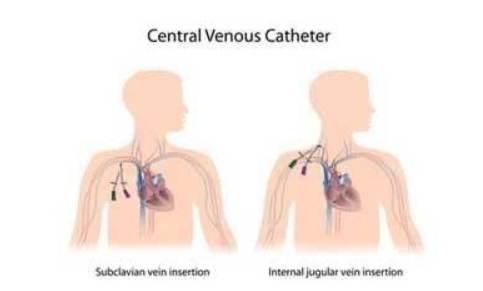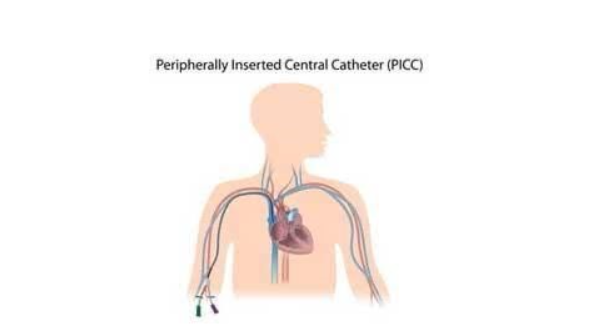Oleh: Thalia Kaylyn Averil
Akses ke sistem vena sentral dilakukan dengan menggunakan Central Venous Catheter (CVC) atau Peripherally Inserted Central Catheter (PICC). Hal ini diperlukan untuk terapi intravena, pengambilan sampel darah, pemantauan, dan berbagai prosedur medis lainnya, terutama ketika akses vena perifer tidak memungkinkan. CVC memiliki tipe tunneled dan non-tunneled CVC. Tunneled CVC dimasukkan dari bawah kulit menuju titik kanulasi, sedangkan non-tunneled CVC diarahkan langsung ke titik kanulasi. Oleh karena itu, non-tunneled CVC perlu diganti setiap beberapa hari hingga seminggu, sedangkan tunneled CVC dapat tetap terpasang selama berminggu-minggu atau berbulan-bulan. Di lain sisi, PICC biasanya direkomendasikan untuk penggunaan jangka pendek hingga menengah yang berkisar antara 4 minggu hingga 6 bulan.
Prosedur pemasangan CVC melibatkan penempatan kateter langsung ke vena-vena yang besar, seperti vena femoralis, vena jugularis interna, vena subklavia, vena cava superior, atau vena cava inferior. Berbeda dengan pemasangan PICC yang menempatkan kateter pada vena-vena yang terletak di lengan, seperti vena basilika, vena brakialis, vena sefalika, atau vena mediana cubiti. Vena-vena tersebut akan bermuara ke salah satu vena besar yang terletak di sekitar jantung, yaitu vena cava superior. PICC menggunakan teknik Seldinger yang terdiri atas menusuk vena dengan jarum, memasukkan guidewire ke dalam vena, kemudian menggerakkan kateter sepanjang guidewire. Kedua prosedur ini seringkali menggunakan panduan USG untuk mengurangi komplikasi dan meningkatkan keberhasilan first-pass, tetapi USG lebih sering digunakan pada CVC.
 Gambar 1. Central Venous Catheter (CVC).
Gambar 1. Central Venous Catheter (CVC).
 Gambar 2. Peripherally Inserted Central Catheter (PICC).
Gambar 2. Peripherally Inserted Central Catheter (PICC).
Indikasi dilakukannya CVC adalah:
- Infus yang tidak kompatibel dilakukan dengan akses vena perifer, seperti vasopresor, kemoterapi, nutrisi parenteral total, dan obat-obatan yang bersifat asam.
- Tenaga kesehatan tidak mampu mendapatkan akses vena perifer dalam keadaan darurat.
- Inisiasi terapi ekstrakorporeal, seperti terapi penggantian ginjal berkelanjutan, plasmaferesis, dan hemodialisis.
- Pemantauan hemodinamik, seperti pengukuran tekanan vena sentral.
- Intervensi vena, seperti pemasangan filter pada vena cava inferior, terapi trombolitik, pacu jantung transvenosa, dan pemasangan stent intravena.
Indikasi dilakukannya PICC adalah:
- Pasien yang memerlukan akses vena selama beberapa minggu hingga bulan karena PICC memiliki tingkat infeksi yang lebih rendah.
- Akses vena perifer yang terbatas.
- Pemberian obat intravena jangka panjang, seperti obat untuk jamur atau antibiotik.
- Pemberian vesicant atau obat yang dapagt mengiritasi vena perifer, seperti obat vasoaktif dan kemoterapi.
- Pemberian larutan hiperosmolar dengan pH yang ekstrim, seperti nutrisi parenteral total.
- Transfusi produk darah, seperti sel darah merah, plasma, platelet, dan lain-lain.
- Pengambilan darah yang sering dan teratur dilakukan.
- Pasien yang mengalami gangguan koagulasi, seperti trombositopenia.
- Kelainan anatomi pada dada dan leher yang mempersulit pemasangan CVC.
CVC dapat memberikan akses langsung untuk memasukkan obat-obatan, produk darah, nutrisi, atau cairan ke dalam aliran darah yang sangat menguntungkan dalam kondisi darurat. Namun, prosedur pemasangan CVC lebih invasif sehingga meningkatkan risiko komplikasi, seperti infeksi dan pneumotoraks. Dalam beberapa tahun terakhir, penggunaan PICC telah meningkat sebagai alternatif CVC, terutama di bidang onkologi dan perawatan kritis karena dianggap lebih mudah dalam pemasangan dan lebih aman. PICC dapat mengurangi risiko terjadinya infeksi terkait kateter dan sepsis, tetapi dapat meningkatkan risiko trombosis vena atau pembentukan gumpalan darah di dalam vena.
| Central Venous Catheter (CVC) | Peripherally Inserted Central Catheter (PICC) |
| Dapat digunakan selama berminggu-minggu atau berbulan-bulan. | Digunakan untuk penggunaan jangka pendek hingga menengah, berkisar antara 4 minggu sampai 6 bulan. |
| Kateter langsung ditempatkan pada vena yang besar sehingga lebih direkomendasikan untuk digunakan dalam keadaan darurat | Kateter di tempatkan pada vena kecil yang terletak di lengan yang akan bermuara di vena cava superior, salah satu vena besar di sekitar jantung. |
| Prosedur lebih invasif dibandingkan dengan PICC | Prosedur lebih tidak invasif dibandingkan dengan CVC |
| Risiko terjadinya komplikasi lebih besar, seperti infeksi dan pneumotoraks | Risiko terjadinya infeksi dan sepsis lebih kecil |
| Risiko terjadinya trombosis vena lebih kecil | Risiko terjadinya trombosis vena lebih besar |
Referensi:
- Santos FKY, Flumignan RLG, Areias LL, Sarpe AKP, Amaral FCF, Ávila RB, Vasconcelos VT, Guedes Neto HJ, Amorim JE, Nakano LCU. Peripherally inserted central catheter versus central venous catheter for intravenous access: A protocol for systematic review and meta-analysis. Medicine (Baltimore). 2020 Jul 24;99(30):e20352. Available from: https://www.ncbi.nlm.nih.gov/pmc/articles/PMC7386962/
- Schmidli J, Widmer MK, Basile C, et al. Editor’s choice—vascular access: 2018 Clinical Practice Guidelines of the European Society for Vascular Surgery (ESVS). Eur J Vasc Endovasc Surg 2018;55:757–818. https://pubmed.ncbi.nlm.nih.gov/29730128
- Johansson E, Hammarskjöld F, Lundberg D, Arnlind H. Advantages and disadvantages of peripherally inserted central venous catheters (PICC) compared to other central venous lines: A systematic review of the literature. Taylor & Francis Online. 2013 Mar 11;52(5). Available from: https://www.tandfonline.com/doi/full/10.3109/0284186X.2013.773072
- Kolikof J, Peterson K, Baker AM. Central Venous Catheter. [Updated 2023 Jul 26]. In: StatPearls [Internet]. Treasure Island (FL): StatPearls Publishing; 2023 Jan-. Available from: https://www.ncbi.nlm.nih.gov/books/NBK557798/
- Gonzalez R, Cassaro S. Percutaneous Central Catheter. [Updated 2023 Sep 4]. In: StatPearls [Internet]. Treasure Island (FL): StatPearls Publishing; 2023 Jan-. Available from: https://www.ncbi.nlm.nih.gov/books/NBK459338/
